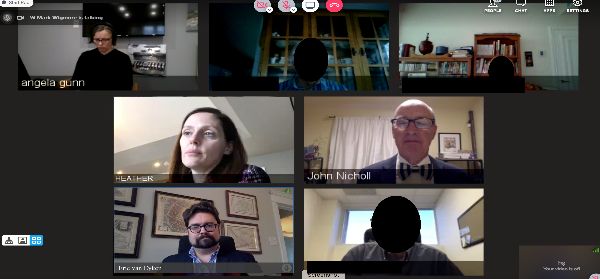Promoters of international arbitration as a means of resolving disputes will often point to the same well known benefits: speed, proportionality, flexibility, pragmatism and business focus. What happens to these benefits, though, when an in-person hearing becomes impossible because of Covid-19?
Our successful experience with a marathon 10 hour virtual arbitration hearing on March 25 involving 12 active participants and approximately 30 observers in Europe, the UK, the U.S. and Canada suggests that the show can go on in spite of the coronavirus, provided that the arbitration panel and the parties are willing to be flexible and pragmatic about practical issues and technical constraints.
Following marathon discoveries involving 43 depositions in many different places, some of them by video-conference, our multi-party reinsurance arbitration was heard by the 3 person Panel in Edmonton in January 2020, nearly a year to the day after the initial procedural hearing. The parties were to reconvene before the Panel in Toronto for one day of closing argument in late March 2020.
As the coronavirus went from a local, to regional, to global pandemic that closed borders and airports, the challenge was how to come up with virtual hearing arrangements that would comply with the arbitration schedule and accommodate the participants' inability to leave their homes, while still respecting the most basic rule of the adversarial system – audi alteram partem – that underlies both the Model Law (Article 18) and the NY Convention (Article V(1)(b)).
Fortunately the Panel, the parties and the court reporter had a lot of experience working together and were sufficiently committed to the process that arrangements for the hearing could be hammered out quickly and collaboratively. The platform chosen was BlueJeans, and although there were occasional technical hiccups, the hearing (including set-up) was completed in about 10 hours with the Panel, the court reporter, all counsel and all clients and observers participating from their homes.

Some takeaways and thoughts for others who may find themselves in the same situation:
- This feels weird: for counsel who are used to the more traditional courtroom or arbitration hearing settings, the intimacy of speaking from your home office or your living room to the Panel in their home offices or living rooms is disorienting and takes some getting used to. In our arbitration, the Panel and counsel had fortunately evolved a less formal style, and this made the transition to virtual reality easier.
- Talk early, talk often: in our arbitration the Panel, counsel, and the court reporter had already established channels of communication with designated "point persons" for scheduling and technical issues. This allowed early and effective consideration of alternate plans for the hearing, once it became apparent that an in-person hearing would not be possible, and decisions could be made without having to get all stakeholders on a conference call.
- Technical wizardry: conferencing technology has come a long way, and not everyone who is using it has to understand it, as long as the technical point people and their IT support do. A technical moderator or master of ceremonies helps, and counsel may need their own technical assistance in presenting PowerPoints and other audio visual material. The technical point people need to speak to IT professionals and vendors to make a joint determination as to what software will be selected. In this regard, questions need to be asked about how individual users will make use of it. This can be a challenge, as most participants will access the software at home without IT tech support, and on computers that will have a variety of security measures and capabilities.
- Testing, testing: Run a test of the software. And run that test again, expanding the circle of those who participate in the test to include first the core team, then other counsel, and clients, and finally all who will be present at the arbitration (including any court reporters and other vendors). In this regard, it is key to be patient and to remind people that the purpose of testing is to identify and resolve aspects that may go wrong. Lawyers are not used to presenting unfinished work to arbitrators or clients, even in a test environment. However, the purpose of testing is to ensure that the software used is properly accessed by everyone, work out technical challenges, and get everyone familiar with how its's used -especially locating the mute button! In conducting a test, the point people have to be humorous and engaging as everyone learns how the software works.
- Be prepared: to revisit the software used following a test. It has to work for everyone. Will follow-up be required with the client's IT team to allow installation? Does a user want a private test? Lawyers too often think of making adjustments as an admission that a mistake was made. That's not the purpose of testing: which is rather to ensure that the hearing goes forward without interruption.
- Whole Day Plan: Consider not just the virtual hearing itself, but the rest of the day. When can people log-in that morning? How will break-out sessions happen? How will the Panel deliberate? How do co-counsel and clients give input? What's happening during lunch and breaks?
- Think about lead counsel: Those actually arguing must be able to both see and engage with the Panel and control any presentation or exhibits being shown. Will they require a second screen or device (such as a second iPad) to make that happen? What about their background and environment? What about the wall art behind them? Ask them to think about what adjustments to their space are required so that they feel comfortable and professional presenting an argument in their environment.
- Imperfection is normal: As noted above, there is an intimacy in delivering argument by videoconference from one's home. There will be hiccups, whether noises from outside, kids screaming, hungry pets, or internet disconnects. What's important is that everyone participating expects that those will happen. In this regard, our pre-hearing testing was important in setting expectations.
- Have a Plan C: Have a back-up plan ready just in case, whether it's ensuring the VC is being recorded should the court reporter disconnect, a dial-in number in case a participant can't connect, or being ready with alternative dates.
- Competent real-time court reporting is golden: our court reporter Angela Gunn was truly the hero of the day. Transcribing an all-day virtual hearing with 12 participants and a live real-time feed takes experience, discipline, stamina, and the ability to deal with problems without getting flustered. Find someone who has done this before, if possible. In our arbitration it helped that we had been working with Angela and her colleagues since the outset, so she already knew who was who and was familiar with people's voices and speaking styles.
Bottom line: if there is a genuine common will to hold a virtual hearing, there is a way to do it without prejudicing the client's interests, while maintaining the prerogatives of the Panel and the right of each party to a fair hearing. It is not the same, but (barking dogs and dubious taste in wall art aside) it is not better or worse than an in-person hearing, it's just different, so it takes some thought and preparation before you do it for the first time.
The content of this article is intended to provide a general guide to the subject matter. Specialist advice should be sought about your specific circumstances.


